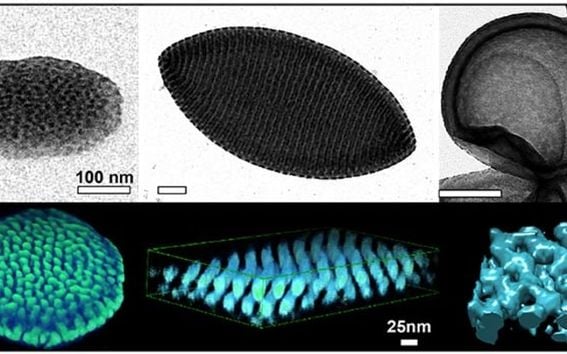Rational Polymer Design Gives Access to Soft Matter Nanoparticle Libraries

Team of international researchers of molecular materials combined theoretical and experimental expertise to develop design rules for complex self-assembled nanosystems.
Collaboration between Aalto University, Department of Applied Physics (Prof. Olli Ikkala, Dr. André Gröshel and coworkers), University of Pau, France (Dr. Oleg Borisov) and University of Mainz, Germany (Prof. Axel Müller), created highly uniform particle species with predictable and defined geometries as well as controlled surface pattern.
As working horse for the study, they used ABC Triblock Terpolymers, i.e. polymers consisting of three chemically different polymer segments. In the segments each block was assigned to a distinct function: one block forms the particle core, one the surface patch, and one stabilizes the superstructure. Synthetic variation of the block lengths allowed the independent combinatorial screening of micelle geometries and surface patch morphology. In this way, the researchers could reveal a library of 13 mostly unknown nanostructures including spotted spherical nanoparticles, cylindrical double helices, perforated discs and striped vesicles (polymersomes), amongst others (see Figure 1) using advanced 3D transmission electron microscopy techniques.
Figure 1: Overview of nanoparticle library with distinct patch geometries.Scale bars are 200 nanometers.
Knowledge of the underlying assembly mechanisms might open the door for future applications, where particles or templates are required with controlled geometry and nanoscale resolution.
For instance, vesicular polymer structures with perforated membrane might be useful as transport vehicles for the simultaneous storage of multiple drugs, vitamins or preserving agents, and the selective release at specific target sites (e.g. tumour environment). Spherical particles with precise number of addressable surface spots could function as virus mimics or for controlled co-assembly with plasmonic particles, while helical cylinders could even lead to chiral plasmonics.
Research article:
Rational design of ABC triblock terpolymer solution nanostructures with controlled patch morphology.
Tina I. Löbling, Oleg Borisov, Johannes S. Haataja, Olli Ikkala, André H. Gröschel, Axel H. E. Müller.
Nature Communications, Volume 7. DOI: 10.1038/ncomms12097
More Information
Academy Professor Olli Ikkala
Department of Applied Physics, Aalto University
[email protected]
Professor Dr. André Gröschel
Physical Chemistry and Centre for Nanointegration Duisburg-Essen
University of Duisburg-Essen
[email protected]
Read more news

Get to know us: Associate Professor Maria Sammalkorpi
Sammalkorpi received her doctorate from Helsinki University of Technology 2004. After her defence, she has worked as a researcher at the Universities of Princeton, Yale and Aalto.
Aalto computer scientists in ICML 2024
Computer scientists in ICML 2024
Getting bacteria into line
Physicists use magnetic fields to manipulate bacterial behaviour